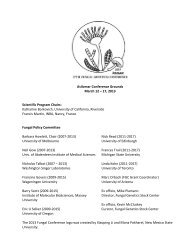Asperfest 4 Program - Fungal Genetics Stock Center
Asperfest 4 Program - Fungal Genetics Stock Center
Asperfest 4 Program - Fungal Genetics Stock Center
Create successful ePaper yourself
Turn your PDF publications into a flip-book with our unique Google optimized e-Paper software.
28. Aspergillus oryzae atfA encodes a transcription factor, which is required for vigorous growth in the solid-state<br />
1 1 1 1 2 3 1<br />
fermentation. K. Sakamoto , O. Yamada , Y. Okita , K. Iwashita , O. Akita , K. Gomi , S. Mikami 1 National Research Institute<br />
of Brewing, 3-7-1 Kagamiyama Higashi-Hiroshima, Hiroshima, Japan. 2 Jissen women's University, 4-1-1 Osakaue, Hino, Tokyo,<br />
Japan. 3 Tohoku University, 1-1 Tsutsumidori-Amamiyatyou Aoba Sendai, Miyagi, Japan<br />
In the solid-state culture, Aspergillus oryzae exhibits phenotypes such as the high production of enzymes and conidiophore<br />
development. Though these characteristics should involve various gene expressions, the only a few regulatory systems have been<br />
understood. From the EST database of A.oryzae, we found a gene encoding transcription factors that show high homology to atf1<br />
of Shizosaccharomyces pombe and named it atfA. We constructed atfA-deletion strain (DelA51) to analyze the function. The<br />
germination ratio of DelA51 conidia was reduced to 13.7%, while that of wild type (wt) conidia was over 90 %. Furthermore the<br />
DelA51 conidia were more sensitive to stress than wt. Although DelA51 grew as fast as wt in the submerged liquid culture, the growth<br />
of DelA51 was attenuated in solid-state fermentation. High humidity of atmosphere restored the growth of DelA51. Thus we<br />
concluded that atfA is necessary for the vigorous growth on the low water activity substrate. To determine atfA-regulated genes, we<br />
identified 34 cDNAs down regulated in DelA51 under osmotic stress condition using mycroarray.<br />
29. Putative mannose transporters complement a branching/septation defect in Aspergillus nidulans. Loretta Jackson-Hayes,<br />
Lauren Fay, Terry W. Hill and Darlene M. Loprete Departments of Biology and Chemistry, Rhodes College, Memphis, TN 38112.<br />
jacksonhayesl@rhodes.edu<br />
In order to identify novel genes affecting cell wall integrity, we have generated mutant strains of the filamentous fungus Aspergillus<br />
nidulans, which show hypersensitivity to the chitin synthase inhibitor Calcofluor White (CFW). The phenotype of one of these strains<br />
(R205) also shows morphological abnormalities related to branching and septation. We have cloned two DNA fragments from an<br />
A. nidulans genomic DNA library which improve resistance to CFW and restore a more normal phenotype. One fragment is gene<br />
AN8848.3, “MT1”, which shows homology to GDP- mannose transporters. The second fragment is gene AN9298.3, “MT2”, which<br />
is a similar but distinct gene also homologous to GDP-mannose transporters. When separately cloned, the putative GDP-mannose<br />
transporters restore normal phenotype including full restoration of subapical hyphal compartment length and branch density in the<br />
mutant. Sequencing reveals a genetic lesion in Exon 5 of MT1 which causes an alanine to proline substitution and no mutation in MT2<br />
in mutant strain R205. Cloned R205 MT1 containing the Exon 5 mutation does not complement the R205 phenotype. Attempts to<br />
produce null mutants of MT1 did not produce viable transformants, suggesting that AN8848.3 is an essential gene. MT2 null mutants<br />
grow normally under normal growth conditions and show wild type CFW resistance.<br />
30. Characterization of radC, the Aspergillus nidulans homolog of RAD52, a key gene for DNA repair by homologous<br />
recombination. Michael Lynge Nielsen, Gaëlle Lettier, Jakob Blæsbjerg Nielsen and Uffe Hasbro Mortensen<br />
Repair of DNA double-strand breaks (DSBs) is crucial for maintaining genome integrity and failure to repair even a single DNA DSB<br />
is lethal as it causes loss of part of a chromosome during cell division. In the yeast, Saccharomyces cerevisiae, Rad52 plays a<br />
fundamental role in the repair of DSBs by homologous recombination (HR) and among genes involved in DNA DSB repair and HR<br />
deletion of RAD52 produces the most dramatic phenotype. Hence, S. cerevisiae cells lacking Rad52 are impaired in DSB repair and<br />
all types of HR including targeted integration of transforming DNA. Orthologs of RAD52 have been identified in other organisms,<br />
including Schizosaccharomyces pombe, Aspergillus nidulans, chicken, mouse, and human. However, in contrast to S. cerevisiae, the<br />
absence of RAD52 in higher eukaryotes does not result in a severe phenotype, due to the evolution of additional repair pathways and<br />
the role of Rad52 in DNA DSB repair and HR remains unclear. To address the role of Rad52 in higher eukaryotes, we have recently<br />
constructed a radC (homolog of RAD52) deletion mutant in A. nidulans and performed an initial characterization of the mutant strain.<br />
Unlike in S. cerevisiae, where Rad52 is essential for the repair of all types of DNA lesions that require HR, we show that in A.<br />
nidulans it is only required for the repair of a subset of these lesions. Hence, in an evolutionary perspective, HR repair in A. nidulans<br />
may represent an intermediate state between S. cerevisiae and human and A. nidulans may therefore be a useful model to further the<br />
understanding of HR in higher eukaryotes.<br />
4th International Aspergillus Meeting 14 Poster Abstracts











